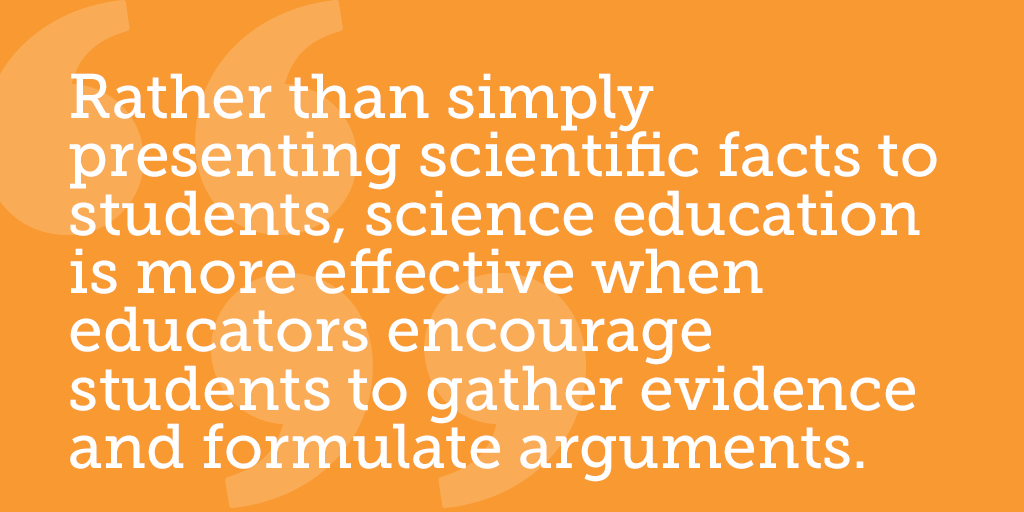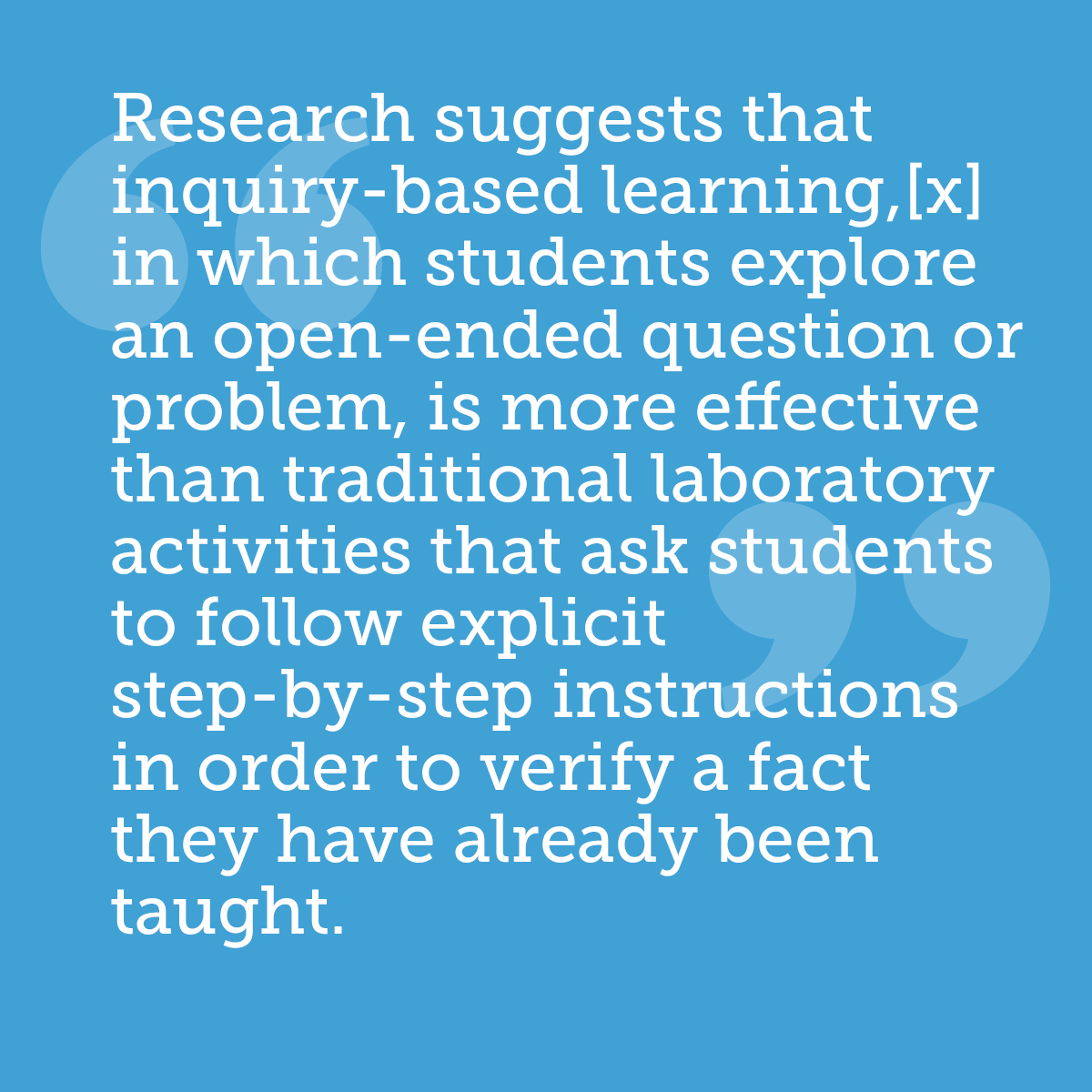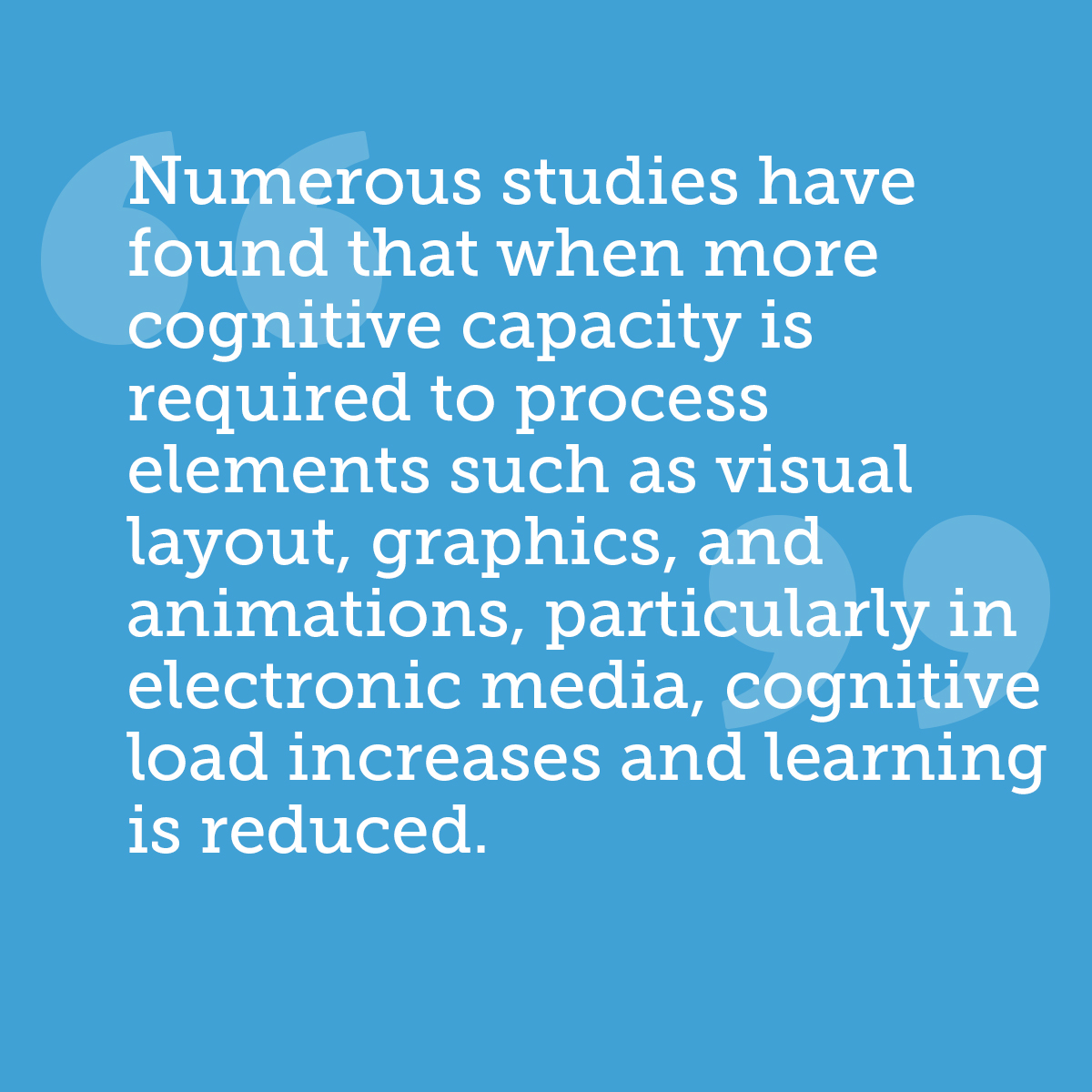
How can we support student learning in STEM subjects?
Children begin using an informal version of the scientific method as infants as they take in information from their senses, form ideas about how the world works, and test and revise their hypotheses based on new information.[i] STEM (Science, Technology, Engineering, and Math) education builds on children’s natural tendency to explore and understand the world around them by teaching students STEM content as well as STEM skills and processes including: the practices of scientific reasoning (how to gather and evaluate evidence to form hypotheses, assess the validity of claims, develop predictions, and establish reasoned arguments), the engineering design process (how to ask questions to understand a problem, brainstorm possibilities, design a solution, and create, test and improve the design)[ii], and the use of mathematics and computational thinking.[iii]
Incorporating technology and multimedia materials into the classroom can help make challenging STEM concepts easier for students to understand.[iv] As technology advances and is more widely used in schools, the potential for communicating information in multiple formats – through pictures, sounds, videos, animations, electronic games, and more – continues to expand. Multimedia learning environments that combine audio and visual information can be more effective than traditional approaches that only present information in one form.[v] An analysis of dozens of studies found that student learning outcomes improved when visual material was accompanied by spoken, rather than written, explanations.[vi] However, while multimedia learning is often highly effective, it can hinder progress if it overwhelms students with too much information. Careful design of games and other multimedia learning tools is necessary to ensure that the cognitive load (the resources the brain devotes to processing information) of an activity is not too high.[vii]
STEM learning environments that incorporate activities such as laboratory assignments, workshops, games, and problem-based learning can help students actively learn the concepts and skills they need to succeed. Active learning is particularly important for STEM education, and has been found to be beneficial for students’ understanding, retention, and later academic success in science.[viii] Games and multimedia content can be carefully designed to offer engaging, interactive opportunities that promote active learning for STEM students.[ix]
The sections below highlight key findings from the research on STEM Education and Multimedia Learning.
 Scientific argumentation is a student’s ability to develop a claim and justify it with clear reasoning and strong evidence.[x] Rather than simply presenting scientific facts to students, science education is more effective when educators encourage students to gather evidence and formulate arguments. For example, educators can facilitate student participation and engagement,[xi] outline the reasoning behind scientific explanations,[xii] and have students work in groups to develop arguments.[xiii] Research shows that it is important that educators understand the principles of scientific argumentation, and receive training in how to foster these skills in students.[xiv]
Scientific argumentation is a student’s ability to develop a claim and justify it with clear reasoning and strong evidence.[x] Rather than simply presenting scientific facts to students, science education is more effective when educators encourage students to gather evidence and formulate arguments. For example, educators can facilitate student participation and engagement,[xi] outline the reasoning behind scientific explanations,[xii] and have students work in groups to develop arguments.[xiii] Research shows that it is important that educators understand the principles of scientific argumentation, and receive training in how to foster these skills in students.[xiv]
 Allowing students to develop their own scientific explanations for certain phenomena can support their scientific knowledge and scientific argumentation skills.[xv] For instance, research suggests that inquiry-based learning,[xvi] in which students explore an open-ended question or problem, is more effective than traditional laboratory activities that ask students to follow explicit step-by-step instructions in order to verify a fact they have already been taught.[xvii] One promising area for student inquiry is socioscientific issues (SSI), or controversial social issues that are related to science, such as the genetic modification of food crops or the ethics of cloning. By connecting science to social issues, SSI instruction can engage students and deepen science learning.[xviii]
Allowing students to develop their own scientific explanations for certain phenomena can support their scientific knowledge and scientific argumentation skills.[xv] For instance, research suggests that inquiry-based learning,[xvi] in which students explore an open-ended question or problem, is more effective than traditional laboratory activities that ask students to follow explicit step-by-step instructions in order to verify a fact they have already been taught.[xvii] One promising area for student inquiry is socioscientific issues (SSI), or controversial social issues that are related to science, such as the genetic modification of food crops or the ethics of cloning. By connecting science to social issues, SSI instruction can engage students and deepen science learning.[xviii]
Given the importance of “learning by doing” in STEM education, technology can serve as a powerful tool providing opportunities for interactive and engaged learning. For example, dynamic computer-based visualizations and simulations allow students to explore scientific phenomena that can be difficult to understand solely through text and static visuals.[xix] Supplementary materials like podcasts and video lectures can provide access to scientific content when students need it, helping students to solidify and expand on the information they learn in the classroom.[xx] Some research suggests that digital learning activities can help develop both students’ scientific reasoning skills and their understanding of particular science concepts.[xxi] In order to be effective, technology tools need to be tailored to work for specific audiences and to meet specific learning goals, as well as thoughtfully integrated into the broader curriculum.[xxii]

Numerous studies have found that when more cognitive capacity is required to process elements such as visual layout, graphics, and animations, particularly in electronic media, cognitive load increases and learning is reduced.[xxiii] Cognitive load can be minimized by simplifying visuals, removing extraneous or redundant information, and reducing the amount of visual information contained on a single page or screen.[xxiv] In this way, learners receive the benefits of the combination of audio and visual material without being overwhelmed by information.
Students with less knowledge of a topic may benefit from well-defined structures and guidance to help them organize new information and incorporate it into long-term memory. However, these kinds of supports may actually interfere with the learning process for more advanced students (a dynamic known as the expertise reversal effect).[xxv] For example, advanced students may find extra audio and visual elements to be redundant, as these features increase their cognitive load without adding value. To address this challenge, designers of multimedia educational programming should consider removing redundant prompts as students advance.[xxvi]
Research also shows that multimedia educational content is most effective when students can control the speed at which material is presented.[xxvii] For example, one study found that learner-paced animations led to better outcomes than animations that followed a preset pace, even if learners only rarely took advantage of the ability to pause the action.[xxviii]
Because they are interactive and engaging, games can be effective tools for active learning and skill building.[xxix] A review of existing research found that “serious games” – those designed for educational purposes rather than simply entertainment – may be more effective than traditional instructional methods.[xxx] In one study, students who participated in digital learning games for a semester demonstrated improved problem-solving skills, while those who received traditional instruction showed no improvement.[xxxi] Learning outcomes can depend on the quality of a game’s design and whether it matches the learning style of the student.[xxxii] Learning from games also depends on the teacher’s familiarity with game-based learning methods and implementation.[xxxiii] Researchers are still exploring how knowledge gained through game play transfers to other areas outside of the classroom where the gaming takes place.
Explore STEM Learning on the Research Map.
Citations
[i] Gopnik, A. (2012). Scientific thinking in young children: Theoretical advances, empirical research, and policy implications. Science, 337(6102), 1623-1627.
[ii] Engineering is Elementary at the Museum of Science, Boston. (2017). The Engineering Design Process.
[iii] The Next Generation Science Standards.
[iv] Chiu, J. L., DeJaegher, C. J., & Chao, J. (2015). The effects of augmented virtual science laboratories on middle school students’ understanding of gas properties. Computers & Education, 85: 59-73.
[v] Mayer, Richard E., & Moreno, Roxana. (1998). A split-attention effect in multimedia learning: Evidence for dual processing systems in working memory. Journal of Educational Psychology, 90(2): 312-320.
[vi] Ginns P. (2005). Meta-analysis of the modality effect. Learning and Instruction, 15(4): 313–331.
[vii] Paas, F., Van Gog, T., & Sweller, J. (2010). Cognitive load theory: New conceptualizations, specifications, and integrated research perspectives. Educational Psychology Review, 22(2): 115-121.
Sweller, J. (1988). Cognitive load during problem solving: Effects on Learning. Cognitive Science, 12: 257-285.
Sweller, J. (1994). Cognitive load theory, learning difficulty, and instructional design. Learning and Instruction, 4: 295-312.
Wong, A., Leahy, W., Marcus, N., & Sweller, J. (2012). Cognitive load theory, the transient information effect and e-learning. Learning and Instruction, 22(6): 449-457.
[viii] Freeman, S., Eddy, S. L., McDonough, M., Smith, M. K., Okoroafor, N., Jordt, H., & Wenderoth, M. P. (2014). Active learning increases student performance in science, engineering, and mathematics. Proceedings of the National Academy of Sciences, 111(23): 8410-8415.
[ix] Abdul Jabbar, A. I., & Felicia, P. (2015). Gameplay engagement and learning in game-based learning: A systematic review. Review of Educational Research, 85(4): 740-779.
Moreno, R. & Mayer, R. (2007). Interactive Multimodal Learning Environments. Educational Psychology Review, 19(3): 309-326.
[x] Osborne, J. F., & Patterson, A. (2011). Scientific argument and explanation: A necessary distinction?. Science Education, 95(4), 627-638.
[xi] Factors Affecting the Implementation of Argument in the Elementary Science Classroom. A Longitudinal Case Study[Article] Martin AM, Hand B,RES SCI EDUC (2009).
[xii] Scientific explanations: Characterizing and evaluating the effects of teachers’ instructional practices on student…[Article] Mcneill KL, Krajcik J,J RES SCI TEACH (2008).
[xiii] The Impact of Collaboration on the Outcomes of Scientific Argumentation [Review] Sampson V, Clark D,SCI EDUC (2009).
[xiv] Learning to Teach Elementary School Science as Argument [Article] Zembal-Saul C,SCI EDUC (2009)
[xv] Fostering second graders’ scientific explanations: A beginning elementary teacher’s knowledge, beliefs, and practice [Article] Beyer CJ, Davis EA,J LEARN SCI (2008).
[xvi]https://media.collegeboard.com/digitalServices/pdf/ap/IN120085064_Chemistry_TeacherLabManual_2013_Ch2.pdf
[xvii] Is Inquiry Possible in Light of Accountability?: A Quantitative Comparison of the Relative Effectiveness of Guided... [Article] Blanchard MR, Southerland SA, Osborne JW, Sampson VD, Annetta LA, Granger EM,SCI EDUC (2010)
The Effect of Guided Inquiry-Based Instruction on Middle School Students’ Understanding of Lunar Concepts[Article] Trundle KC, Atwood RK, Christopher JE, Sackes M,RES SCI EDUC (2010).
[xviii] Contextualizing Nature of Science Instruction in Socioscientific Issues [Article] Eastwood JL, Sadler TD, Zeidler DL, Lewis A, Amiri L, Applebaum S,INT J SCI EDUC (2012).
[xix] McElhaney, Kevin W., Chang, Hsin-Yi, Chiu, Jennifer L., & Linn, Marcia C. (2015). Evidence for effective uses of dynamic visualisations in science curriculum materials. Studies In Science Education, 51(1): 49-85.
Rutten, Nico, Van Joolingen, Wouter R., and Van der Veen, Jan T. (2012). The learning effects of computer simulations in science education. Computers & Education, 58(1): 136-153.
[xx] Holbrook, J., & Dupont, C. (2011). Making the decision to provide enhanced podcasts to post-secondary science students. Journal of Science Education and Technology, 20(3): 233-245.
[xxi] She, H. C., & Liao, Y. W. (2010). Bridging scientific reasoning and conceptual change through adaptive web‐based learning. Journal of Research in Science Teaching, 47(1): 91-119.
[xxii] Songer, N. B. (2007). Digital resources versus cognitive tools: A discussion of learning. Handbook of research on science education, edited by Abell, Sandra K., & Lederman, Norman G. New York: Routledge, 471-491.
[xxiii] Kirschner, P. A., Ayres, P., & Chandler, P. (2011). Contemporary cognitive load theory research: The good, the bad and the ugly. Computers in Human Behavior, 27(1), 99105.
[xxiv] Lee, H., Plaas, J. L., & Homer, B. D. (2006). Optimizing cognitive load for learning from computer- based science simulations. Journal of Educational Psychology, 98(4), 902913.
Plass, J. L., Homer, B. D., & Hayward, E. O. (2009). Design factors for educationally effective animations and simulations. Journal of Computing in Higher Education, 21(1), 3161.
[xxv]Expertise reversal effect and its implications for learner-tailored instruction [Review] Kalyuga S,EDUC PSYCHOL REV (2007).
[xxvi] Expertise reversal effect and its implications for learner-tailored instruction [Review] Kalyuga S,EDUC PSYCHOL REV (2007)
Visual representations in science education: The influence of prior knowledge and cognitive load theory on… [Article] Cook MP,SCI EDUC (2006)
[xxvii] https://www.brainpop.com/new_common_images/files/76/76426_BrainPOP_White_Paper-20090426.pdf
[xxviii] Learner control, cognitive load and instructional animation [Article] Hasler BS, Kersten B, Sweller J,APPL COGNITIVE PSYCH (2007). [
[xxix] Abdul Jabbar, A. I., & Felicia, P. (2015). Gameplay engagement and learning in game-based learning: A systematic review. Review of Educational Research, 85(4): 740-779.
[xxx] Wouters, P., Van Nimwegen, C., Van Oostendorp, H., & Van Der Spek, E. D. (2013). A meta-analysis of the cognitive and motivational effects of serious games. Journal of Educational Psychology, 105(2): 249-265.
[xxxi] Yang, Y. T. C. (2012). Building virtual cities, inspiring intelligent citizens: Digital games for developing students’ problem solving and learning motivation. Computers & Education, 59(2): 365-377.
[xxxii] Hwang, G. J., Sung, H. Y., Hung, C. M., Huang, I., & Tsai, C. C. (2012). Development of a personalized educational computer game based on students’ learning styles. Educational Technology Research and Development, 60(4): 623-638.
[xxxiii] Turkay, S., Hoffman, D., Kinzer, C. K., Chantes, P., & Vicari, C. (2014). Toward understanding the potential of games for learning: Learning theory, game design characteristics, and situating video games in classrooms. Computers in the Schools, 31(1-2): 2-22.